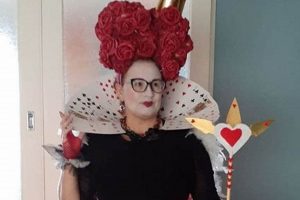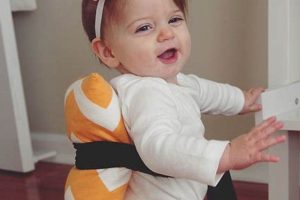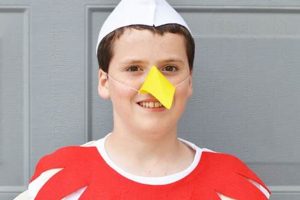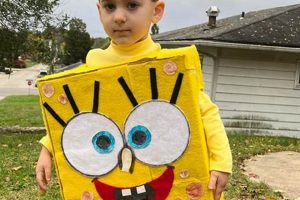The concept centers around creating a homemade attire inspired by the iconic image of a magical effigy. This typically involves simulating the appearance of fabric, stitching, and pins, commonly associated with representations of charmed figures. An example is a garment embellished with faux seams, button eyes, and strategically placed simulated needles.
The appeal of such a project lies in its accessibility and creative potential. It offers a cost-effective alternative to store-bought Halloween options and provides an opportunity for individual expression through personalized design elements. Historically, effigies have held significance in various cultural practices, adding a layer of intrigue to this particular costume choice.
The following sections will explore specific techniques for constructing such a costume, including material selection, embellishment methods, and makeup suggestions to enhance the overall effect.
Crafting an Effective Voodoo Doll Halloween Costume
Constructing a convincing effigy-inspired Halloween attire requires careful consideration of several factors to achieve the desired aesthetic. The following tips provide guidance on key elements for a successful outcome.
Tip 1: Material Selection: Opt for natural, textured fabrics like burlap, linen, or canvas as a base for the garment. These materials contribute to a more authentic and weathered appearance. Avoid overly synthetic or shiny fabrics, which can detract from the intended effect.
Tip 2: Simulated Stitching: Employ thick, contrasting thread to create prominent, oversized stitches along seams and edges. Hand-stitching, rather than machine-stitching, often yields a more convincing and deliberate look. Consider using embroidery floss for added texture.
Tip 3: Button Eyes and Patches: Secure mismatched buttons of varying sizes and colors to the garment to simulate eyes. Patches of contrasting fabric can be strategically placed to suggest repairs or wear and tear. Ensure all attachments are securely fastened to prevent them from detaching during wear.
Tip 4: Pin Placement and Safety: Use faux pins or needles crafted from materials like painted toothpicks or skewers. Secure them to the costume with fabric glue or by threading them through the fabric and securing them on the inside. Exercise extreme caution to avoid any sharp edges or points that could pose a safety hazard.
Tip 5: Makeup Application: Employ makeup to enhance the overall effect. Pale foundation, dark circles around the eyes, and subtle stitched-on effects drawn with eyeliner can contribute to a more convincing doll-like appearance. Consider adding subtle cracking or fading effects for a more aged look.
Tip 6: Accessorizing Appropriately: Incorporate accessories that complement the theme. A small, stitched bag or a miniature effigy prop can enhance the costume’s narrative. Avoid overly elaborate or distracting accessories that detract from the central design.
Tip 7: Emphasis on Texture: Prioritize texture throughout the costume’s design. Layer different fabrics, incorporate rough edges, and utilize distressing techniques to create a visually interesting and tactile effect. A varied texture enhances the perception of age and authenticity.
Careful planning and attention to detail are essential for creating a memorable and impactful effigy-inspired Halloween costume. The utilization of appropriate materials, simulated stitching, and strategic embellishments contributes to a cohesive and visually compelling design.
The following sections will provide additional insights into related costume concepts and creative variations on this theme.
1. Authentic Fabric Textures
The selection of authentic fabric textures is paramount to the successful realization of an effigy-inspired Halloween attire. The intended aesthetic relies on conveying age, wear, and a handmade quality. The effect depends on the material choices at the base of the construction. Burlap, linen, and loosely woven cotton fabrics provide a foundation that directly contributes to the desired “voodoo doll halloween costume diy” result. This authenticity differentiates a convincing costume from a generic or mass-produced appearance.
A failure to prioritize authentic textures often leads to a costume that lacks visual depth and credibility. For example, utilizing synthetic, brightly colored fabrics contradicts the intended theme. In contrast, employing aged, distressed fabrics adds a layer of realism and enhances the overall impact. The distressing process, such as staining or tearing, is best applied to fabrics naturally suited to displaying wear, thus emphasizing the importance of initial material selection. Real-world examples of successful costumes consistently feature materials chosen for their inherent textural qualities. Consider photographs or examples on craft sites of successful iterations.
In conclusion, the significance of authentic fabric textures in crafting an effective effigy-themed Halloween costume cannot be overstated. The use of appropriate materials directly contributes to the costume’s believability and visual appeal. Challenges arise in sourcing suitable aged fabrics, but the effort invested in this aspect significantly elevates the final product, aligning directly with the goals of a compelling “voodoo doll halloween costume diy.”
2. Oversized Stitch Emulation
Oversized stitch emulation functions as a crucial visual cue in the context of a homemade effigy Halloween attire. The exaggerated stitching directly contributes to the overall aesthetic, signifying the handcrafted and often unsettling nature of the figure.
- Visual Signifier of Construction
Oversized stitches immediately convey a sense of construction, implying the figure has been assembled rather than naturally formed. These stitches are often uneven and deliberately conspicuous, visually emphasizing the artificial creation. This visual cue heightens the perception of the figure as a fabricated entity, separate from natural beings. Examples include thick, contrasting thread used along seams, deliberately exposed and exaggerated beyond functional necessity. The implication is a departure from polished, manufactured goods towards a rough, primitive aesthetic.
- Emphasis on Imperfection and Distress
The exaggerated nature of the stitches draws attention to imperfections, reinforcing the impression of age, neglect, or intentional harm. Missing stitches, loosely hanging threads, and mismatched thread colors all contribute to this distressed appearance. An example would be using different colored threads on a single seam. These imperfections amplify the feeling that the doll is damaged or incomplete, contributing to the desired unsettling effect in a ”
voodoo doll halloween costume diy”. - Communicating Handcrafted Origins
Oversized stitch emulation directly communicates the hand-made origin of the costume. This aesthetic distinguishes it from mass-produced costumes, enhancing the perceived effort and authenticity of the design. For example, using visible and imperfect hand-stitching instead of machine stitching. This technique strengthens the connection to traditional folk magic and handmade effigies, enhancing the overall narrative of the costume.
- Symbolic Representation of Connection or Control
In some interpretations, oversized stitches may represent a symbolic connection or control exerted over the effigy. The stitches may be viewed as bindings or constraints, implying manipulation or influence. For example, a series of prominent stitches around the mouth area might symbolize silencing or control over speech. While this interpretation is subjective, it contributes to the multifaceted symbolism associated with effigy imagery and enhances its impact on the viewer.
In summary, oversized stitch emulation fulfills multiple functions, from visually communicating construction and imperfection to reinforcing the handcrafted nature and symbolic implications of the costume. The deliberate exaggeration of these stitches enhances the overall impact and distinguishes it from commercially produced alternatives, increasing the quality of the “voodoo doll halloween costume diy”.
3. Button Eye Placement
Button eye placement represents a critical component within the execution of an effigy-inspired Halloween attire. The positioning, size, and variety of buttons employed as ocular substitutes directly influence the costume’s overall unsettling and artificial aesthetic. Effective button placement contributes to the impression that the effigy is not merely inanimate, but possesses a vacant or disturbed awareness, a key element in realizing the desired “voodoo doll halloween costume diy” effect. Conversely, poorly executed placement diminishes the costume’s intended impact. The visual effect is significantly linked to the proper design.
Varied button types, sizes, and colors augment the sense of disarray and imperfection, hallmarks of effigy construction. For example, mismatched buttons, positioned asymmetrically, cultivate a sense of unease and contribute to the impression of haphazard assembly. In contrast, uniformly sized and symmetrically placed buttons reduce the unnerving effect, resulting in a more conventional or less compelling design. Specific strategic positioning of the buttons can also communicate emotion. Buttons placed high on the face might suggest surprise, while those placed low might convey sadness. The application of makeup to surround the button, giving the appearance of stitched sockets, further enhances the effect.
In summary, the consideration of button eye placement carries substantial weight in achieving a successful effigy-themed Halloween costume. The selection and strategic positioning of varied buttons is essential in fostering the desired effect of unsettling artificiality. Careful planning and execution of this element demonstrably elevate the costume from a generic representation to a convincingly disturbing embodiment, thereby directly contributing to the overall success of the “voodoo doll halloween costume diy” endeavor.
4. Simulated Pin Affixation
Simulated pin affixation constitutes a key element in creating a convincing effigy-inspired Halloween attire, particularly when pursuing a homemade approach. The visual representation of pins inserted into the effigy is critical for conveying the intended theme. The method by which these pins are simulated and attached directly influences the costume’s success in evoking the desired imagery.
- Safety Considerations and Material Choices
The paramount concern in simulated pin affixation is ensuring safety. Actual pins or needles pose a risk of injury and are unsuitable for costume use. Therefore, alternative materials such as painted toothpicks, skewers with blunted ends, or craft foam are utilized. These materials must be securely affixed to the costume to prevent detachment and potential hazards. The selection of adhesive or attachment method is critical; fabric glue or secure stitching provides a safe and reliable bond.
- Visual Realism and Aesthetic Impact
Achieving visual realism is essential to the impact of simulated pin affixation. The simulated pins should closely resemble actual pins in size, shape, and color. Strategic placement enhances the overall effect. Pins clustered in specific areas, such as the heart or head, can amplify the intended thematic message. Variations in pin orientation and depth of insertion contribute to a more dynamic and unsettling appearance. The visual quality of the “voodoo doll halloween costume diy” is enhanced.
- Techniques for Secure Attachment
Various techniques facilitate secure attachment of simulated pins. Fabric glue provides a simple and effective method for adhering lightweight materials to the costume. For heavier materials, stitching or creating small loops to thread the simulated pins through offers greater stability. The choice of attachment method depends on the material of both the costume and the simulated pins, as well as the desired level of permanence. Reinforcement of the attachment point is recommended to withstand movement and handling. This assures durability of the “voodoo doll halloween costume diy”.
- Integration with Overall Costume Design
Simulated pin affixation should be seamlessly integrated with the overall costume design to create a cohesive and impactful visual narrative. The number, placement, and style of simulated pins should complement other elements, such as fabric texture, stitching patterns, and makeup. An overabundance of pins can detract from the overall effect, while too few may render the costume incomplete. A balanced and well-considered approach ensures that the simulated pins contribute effectively to the intended “voodoo doll halloween costume diy” aesthetic.
The successful implementation of simulated pin affixation is integral to achieving a compelling effigy-inspired Halloween attire. Safety considerations, visual realism, secure attachment techniques, and integration with the overall costume design are all crucial factors in creating a visually striking and thematically relevant “voodoo doll halloween costume diy”. The attention of detail assures a high-quality outcome.
5. Makeup for Doll Effect
The application of makeup holds significant importance in realizing an effective effigy-inspired Halloween attire, enhancing the costume’s overall credibility and visual impact. The strategic use of cosmetics transforms a mere garment into a convincing representation, aligning directly with the desired aesthetic.
- Foundation and Complexion Modification
Foundation choice serves as the initial step in achieving the desired doll-like appearance. A foundation shade significantly lighter than the wea
rer’s natural skin tone can create an artificial pallor. Subsequent contouring with grey or brown shades emphasizes hollows in the cheeks and temples, furthering the unnatural effect. This base alters the face’s perceived structure, contributing to the effigy aesthetic often seen in “voodoo doll halloween costume diy” examples online. - Eye Enhancement and Exaggeration
Exaggerating the eyes through makeup application further enhances the doll-like appearance. Large, round eyes are a common characteristic of dolls. This is achieved through the use of white or pale eyeliner on the lower waterline, making the eyes appear larger. Dark eyeshadow applied in a circular fashion amplifies this effect. Additionally, drawing exaggerated lashes, both above and below the eye, contributes to the artificial and stylized aesthetic, a key element in successful “voodoo doll halloween costume diy” looks.
- Mouth and Lip Transformation
Modifying the mouth and lip shape is another effective technique. Smaller, more stylized lips contribute to the doll-like effect. This can be achieved by concealing the natural lip line with foundation and drawing a smaller mouth shape in the center. Alternatively, some designs employ cracked or stitched lip effects using eyeliner, further enhancing the damaged and artificial aesthetic often found in “voodoo doll halloween costume diy” tutorials. The lip is therefore used as a canvas for a doll-like look.
- Stitching and Damage Simulation
Makeup is effectively used to simulate stitching or damage, contributing to the effigy aesthetic. Fine lines drawn with eyeliner replicate stitches across the face, particularly around the mouth or eyes. Alternatively, cracking effects can be achieved using liquid latex and foundation, creating the impression of damaged porcelain. This element of constructed damage is a common thread in many “voodoo doll halloween costume diy” executions and can enhance the believability of the costume.
In conclusion, makeup application functions as a powerful tool in elevating an effigy-inspired Halloween attire. Strategic contouring, eye and lip modification, and the simulation of stitches or damage contribute to a convincing and unsettling doll-like appearance. This combination helps transform the costume into a truly memorable “voodoo doll halloween costume diy” through careful selection of cosmetic designs.
Frequently Asked Questions
The following addresses common inquiries regarding the creation and execution of effigy-inspired Halloween attire. These answers aim to provide clarity and guidance on key aspects of costume construction.
Question 1: What materials are most suitable for creating an authentic effigy-inspired appearance?
Natural, textured fabrics such as burlap, linen, and canvas are recommended. These materials convey a sense of age, wear, and handcrafted construction, aligning with the intended aesthetic. Avoid synthetic or overly polished fabrics that detract from the desired effect.
Question 2: How can simulated stitching be effectively incorporated into the costume design?
Employ thick, contrasting thread to create prominent, oversized stitches along seams and edges. Hand-stitching, rather than machine-stitching, yields a more convincing and deliberate appearance. Consider varying thread colors and intentionally creating uneven stitches to enhance the distressed aesthetic.
Question 3: What are the safest methods for simulating pins or needles on the costume?
Utilize alternative materials such as painted toothpicks, skewers with blunted ends, or craft foam to represent pins or needles. Secure these materials to the costume using fabric glue or by threading them through the fabric and securing them on the inside. Exercise caution to prevent any sharp edges or points that could pose a safety hazard.
Question 4: How can makeup be utilized to enhance the overall doll-like effect?
Pale foundation, dark circles around the eyes, and subtle stitched-on effects drawn with eyeliner contribute to a more convincing doll-like appearance. Consider adding subtle cracking or fading effects for a more aged look. Contouring can further enhance the unnatural facial structure.
Question 5: What accessories are appropriate to complement the costume?
Incorporate accessories that align with the theme. A small, stitched bag or a miniature effigy prop can enhance the costume’s narrative. Avoid overly elaborate or distracting accessories that detract from the central design. Restraint is key to maintaining focus on the core aesthetic.
Question 6: Are there any cultural sensitivities to consider when creating this costume?
While inspired by a generalized representation of effigies, sensitivity to actual cultural practices is essential. Avoid any elements that could be interpreted as disrespectful or appropriative of specific cultural or religious traditions. Researching the historical context of effigy use in various cultures is recommended.
The implementation of these guidelines allows for the creation of a safe and visually compelling effigy-inspired Halloween costume.
The following section will address advanced techniques and creative adaptations of this costume concept.
Conclusion
The preceding analysis has provided a comprehensive overview of the design, construction, and considerations involved in crafting a “voodoo doll halloween costume diy”. From material selection and stitching techniques to simulated pin affixation and makeup application, the various aspects of this costume concept have been thoroughly examined.
The creation of a compelling “voodoo doll halloween costume diy” necessitates a thoughtful balance of artistic expression, technical skill, and cultural awareness. Individuals undertaking this project are encouraged to proceed with diligence, creativity, and a commitment to responsible representation. The resulting outcome should be a testament to both craftsmanship and informed understanding.







